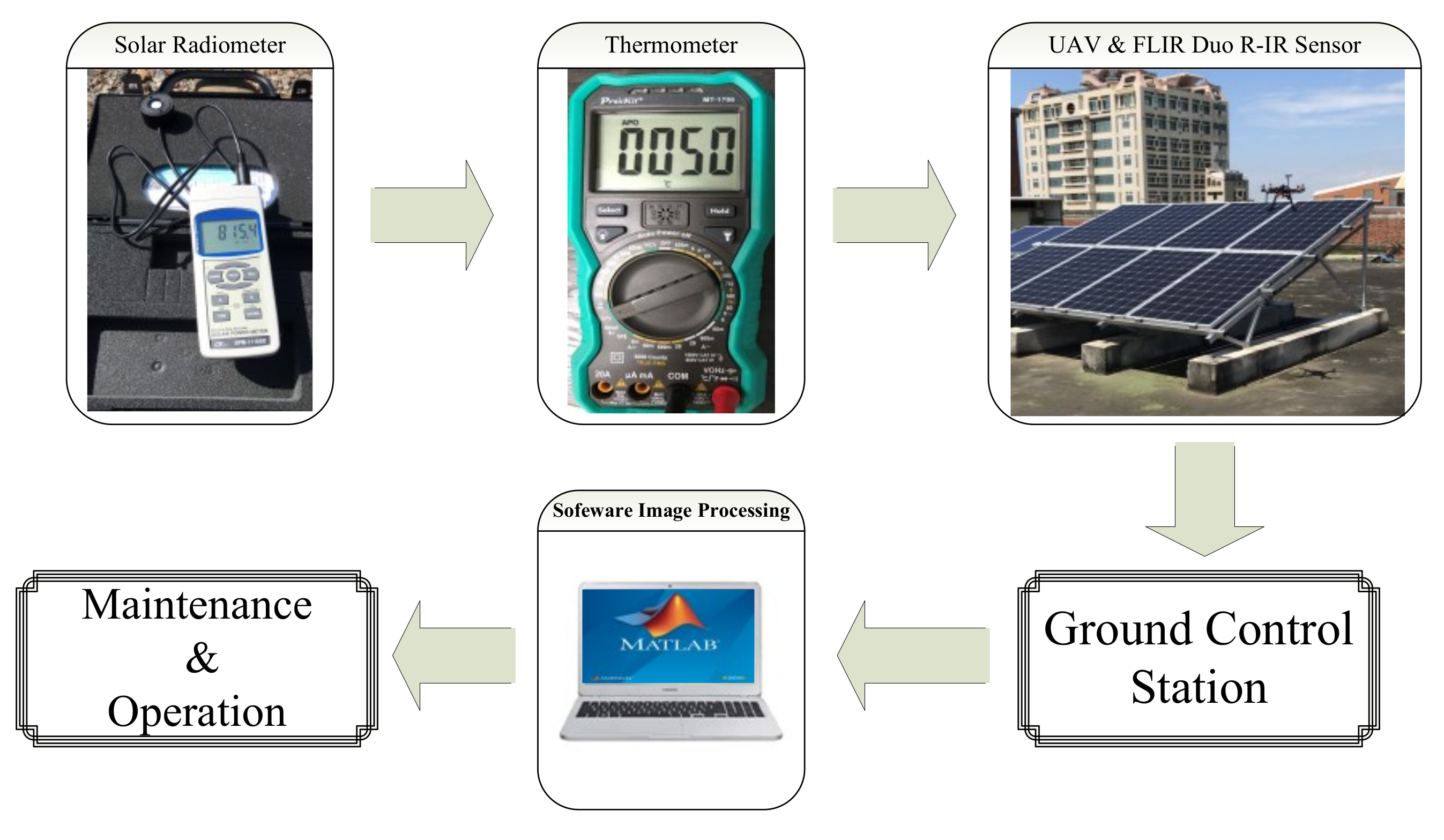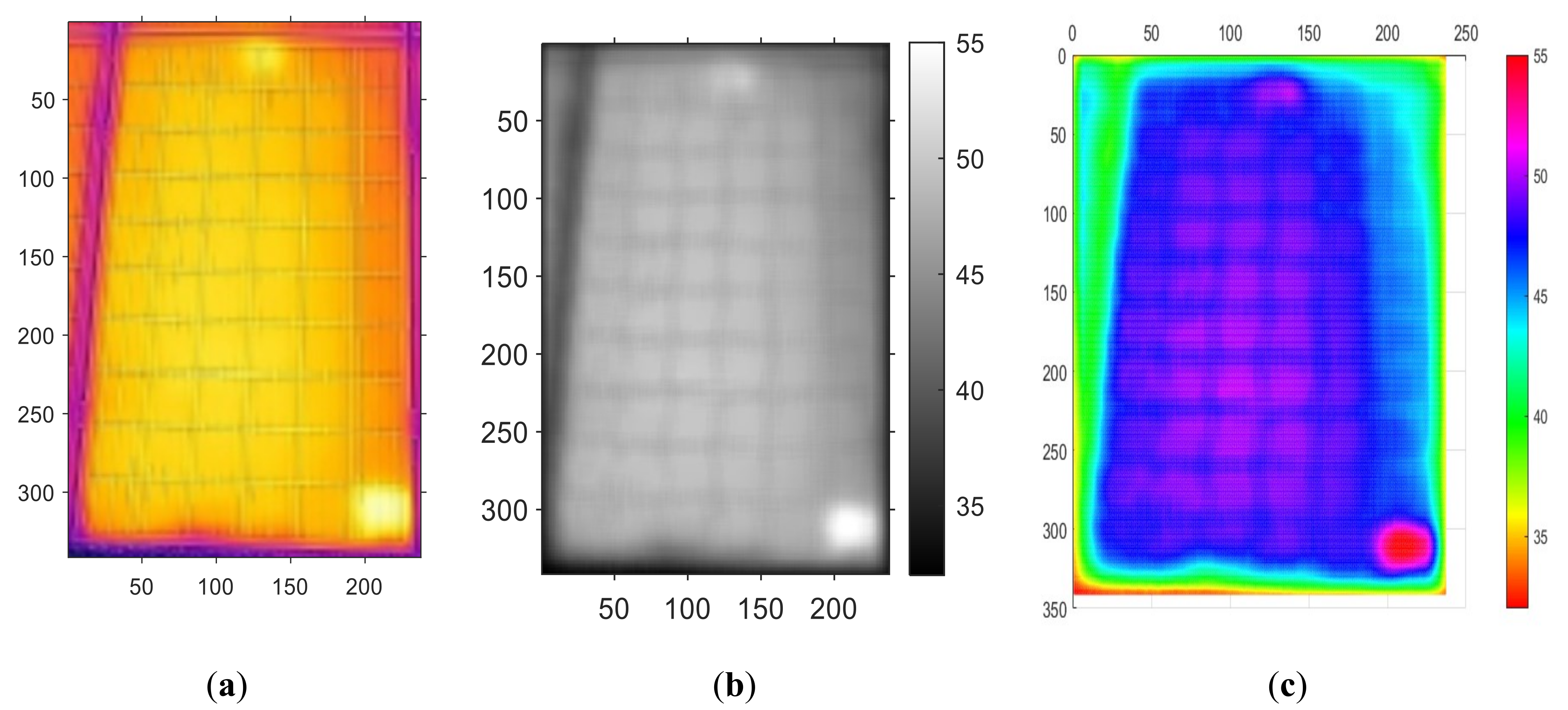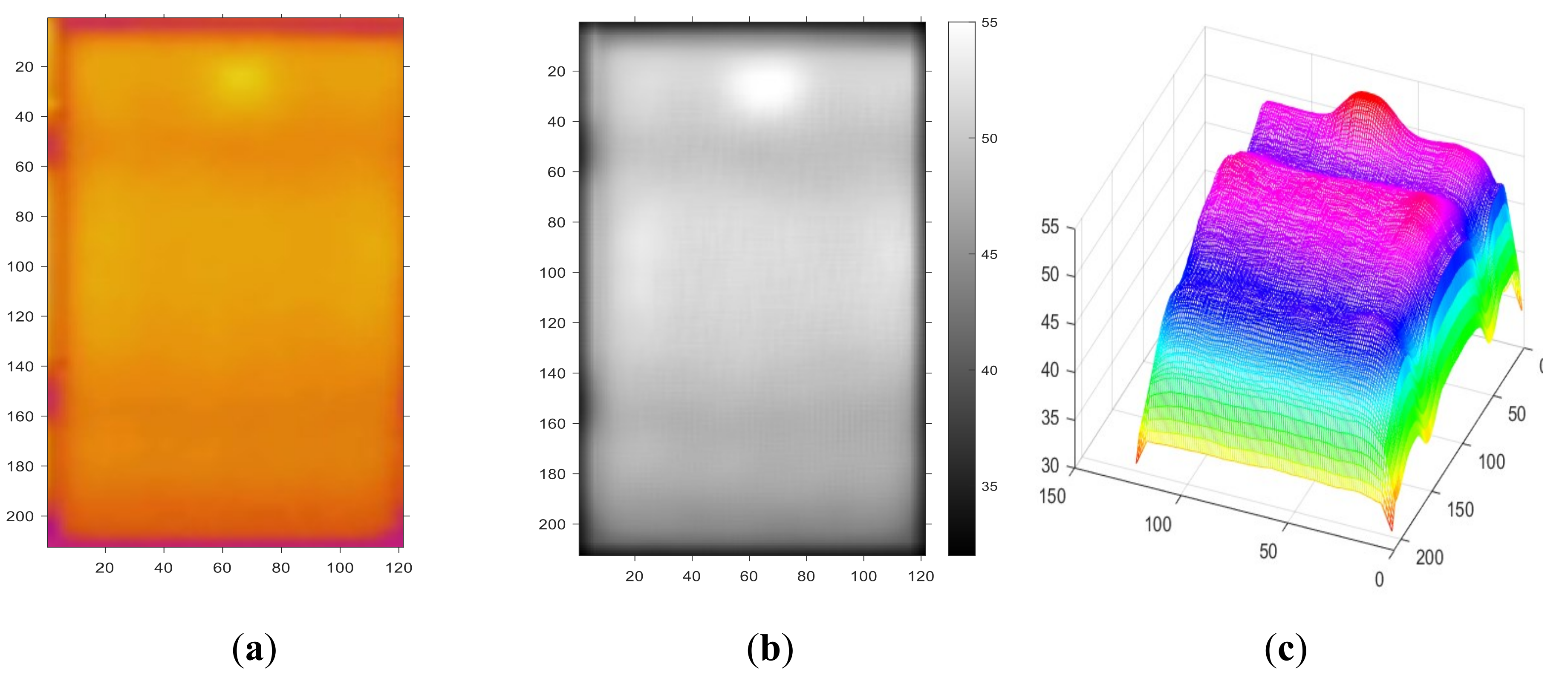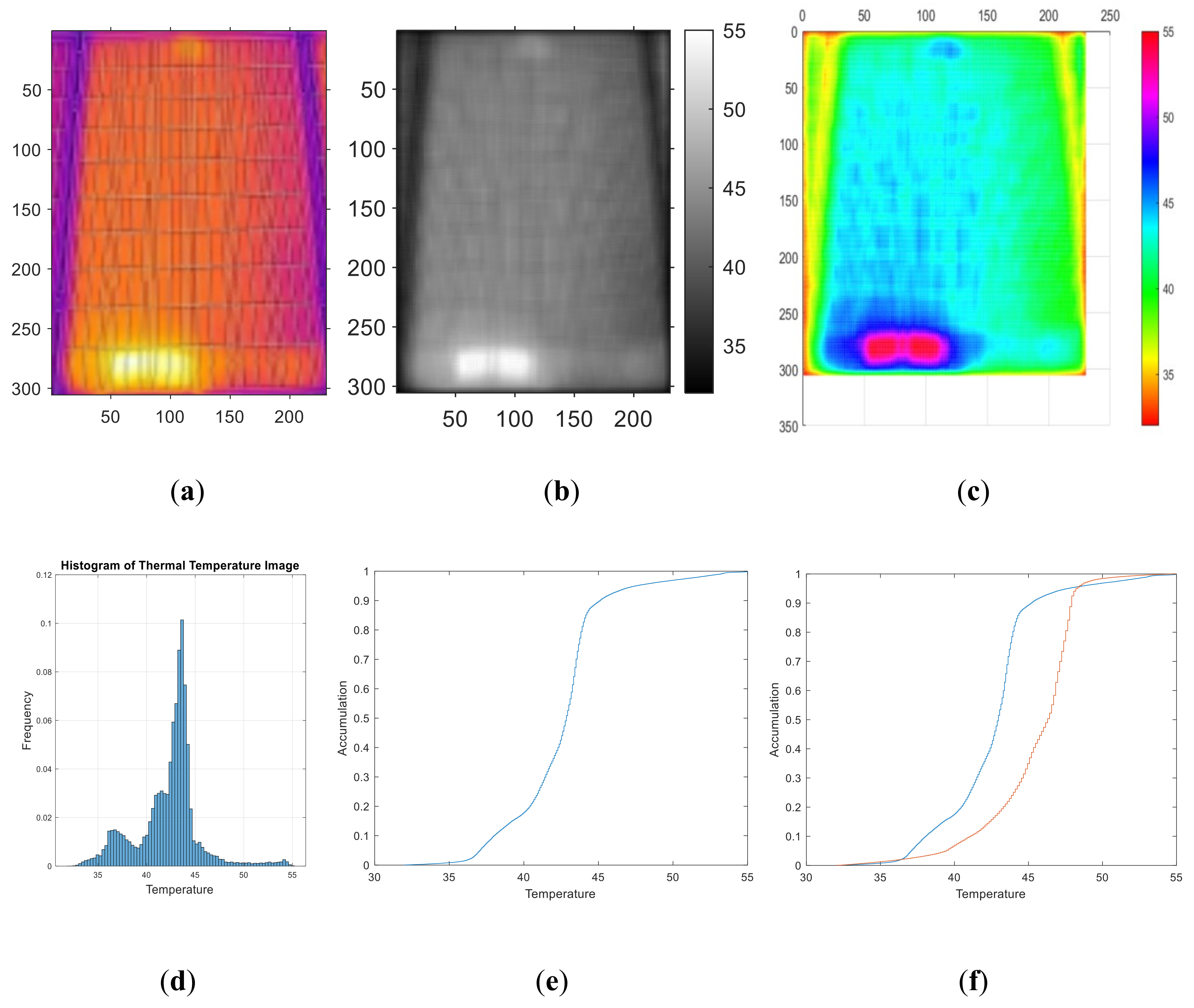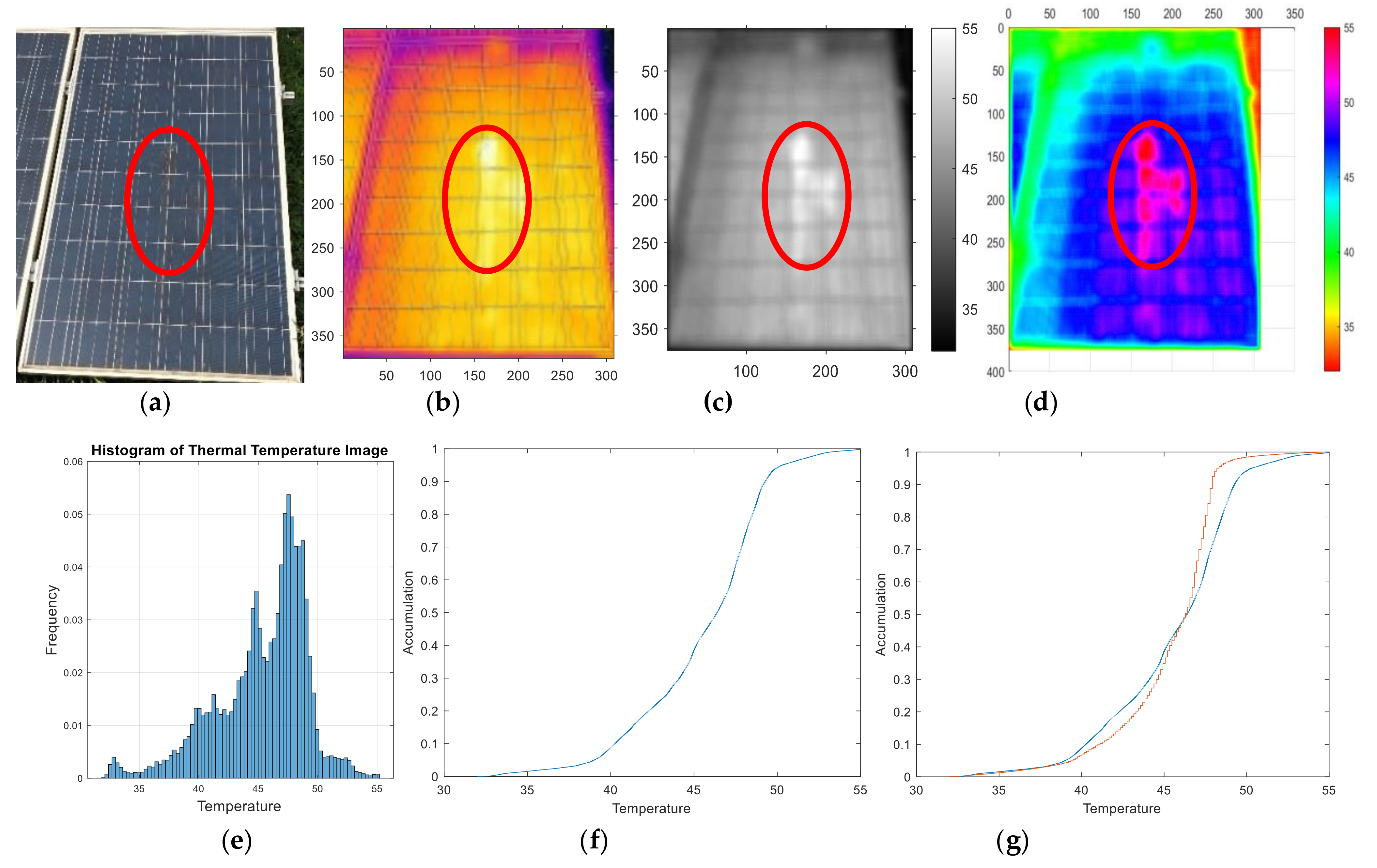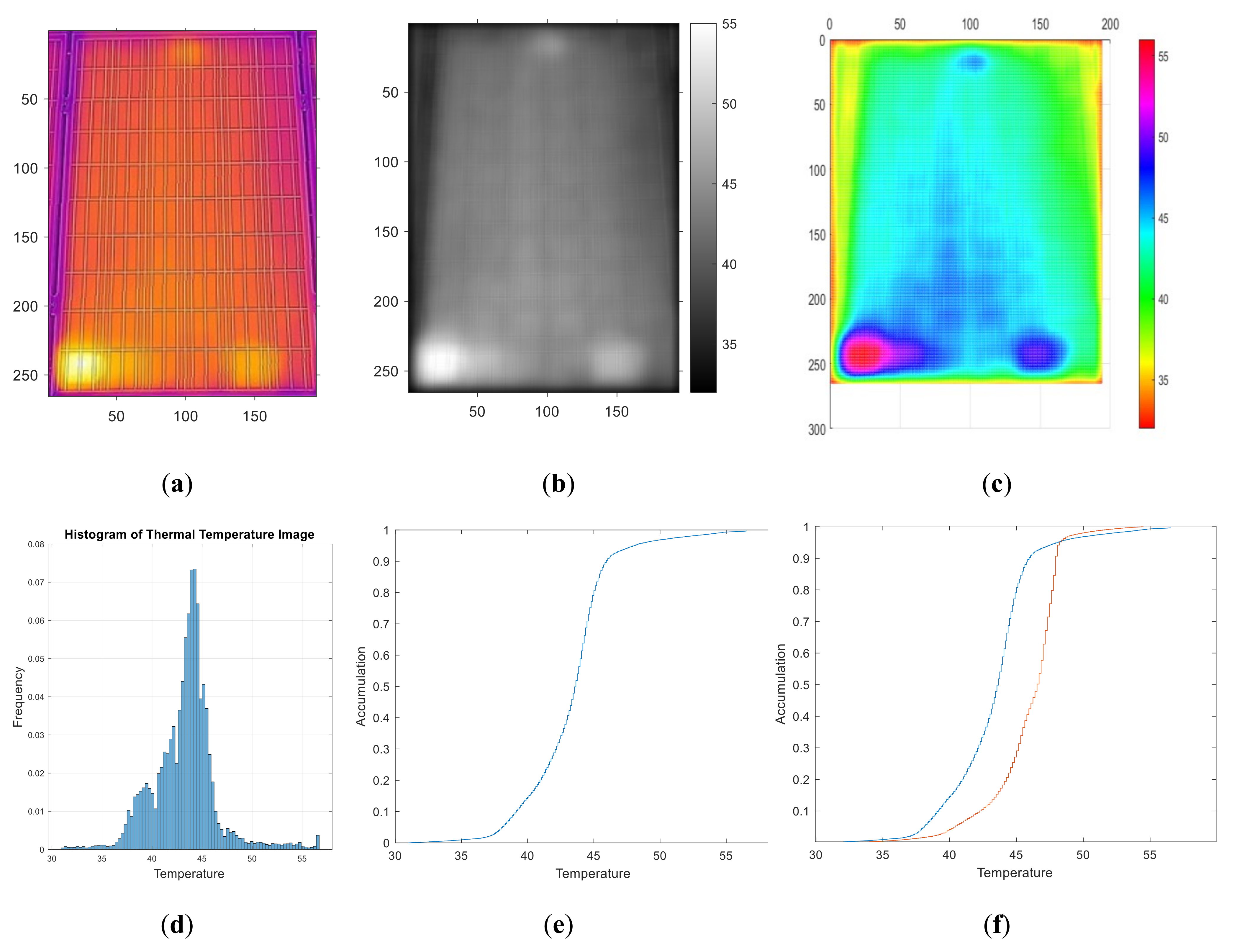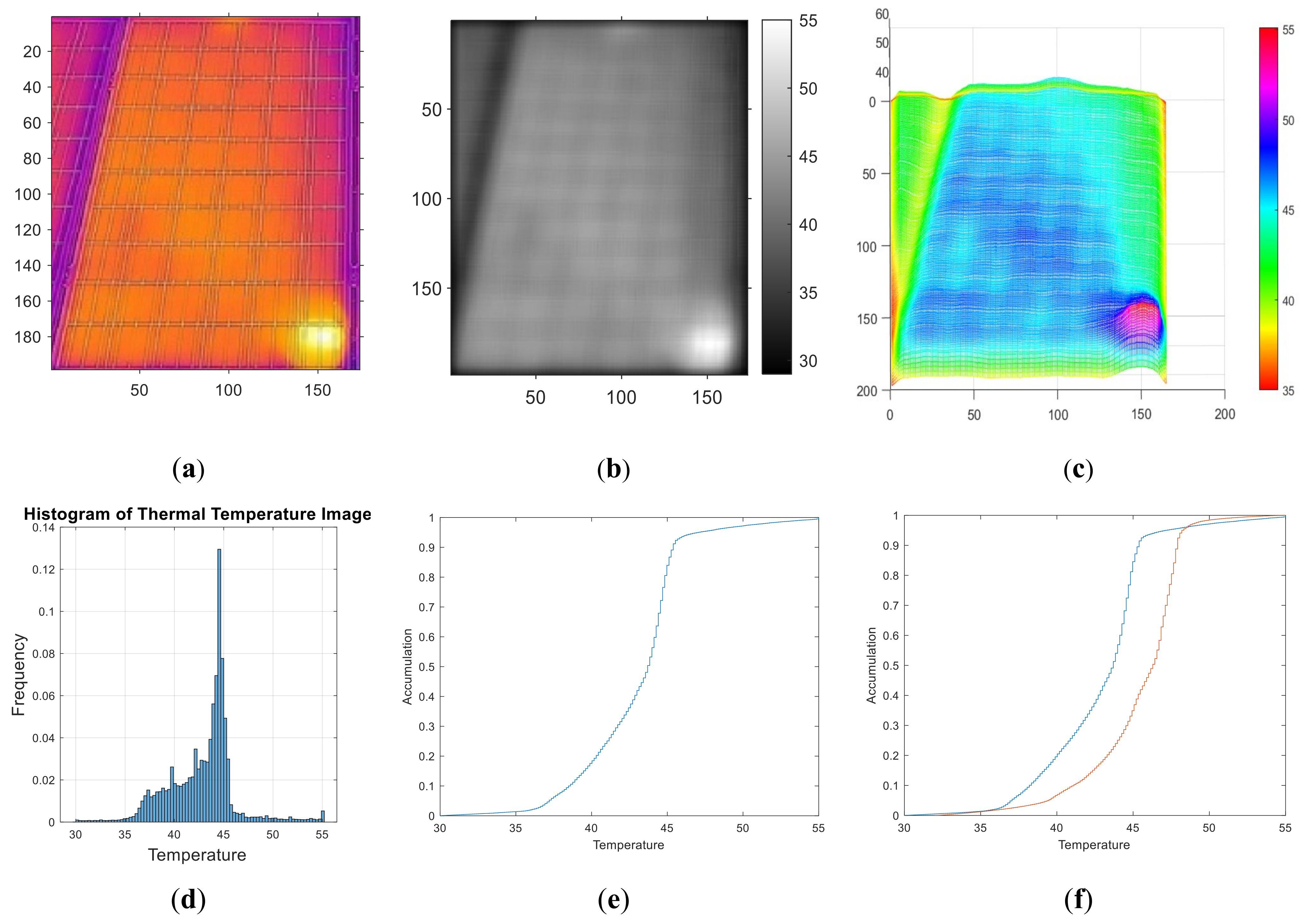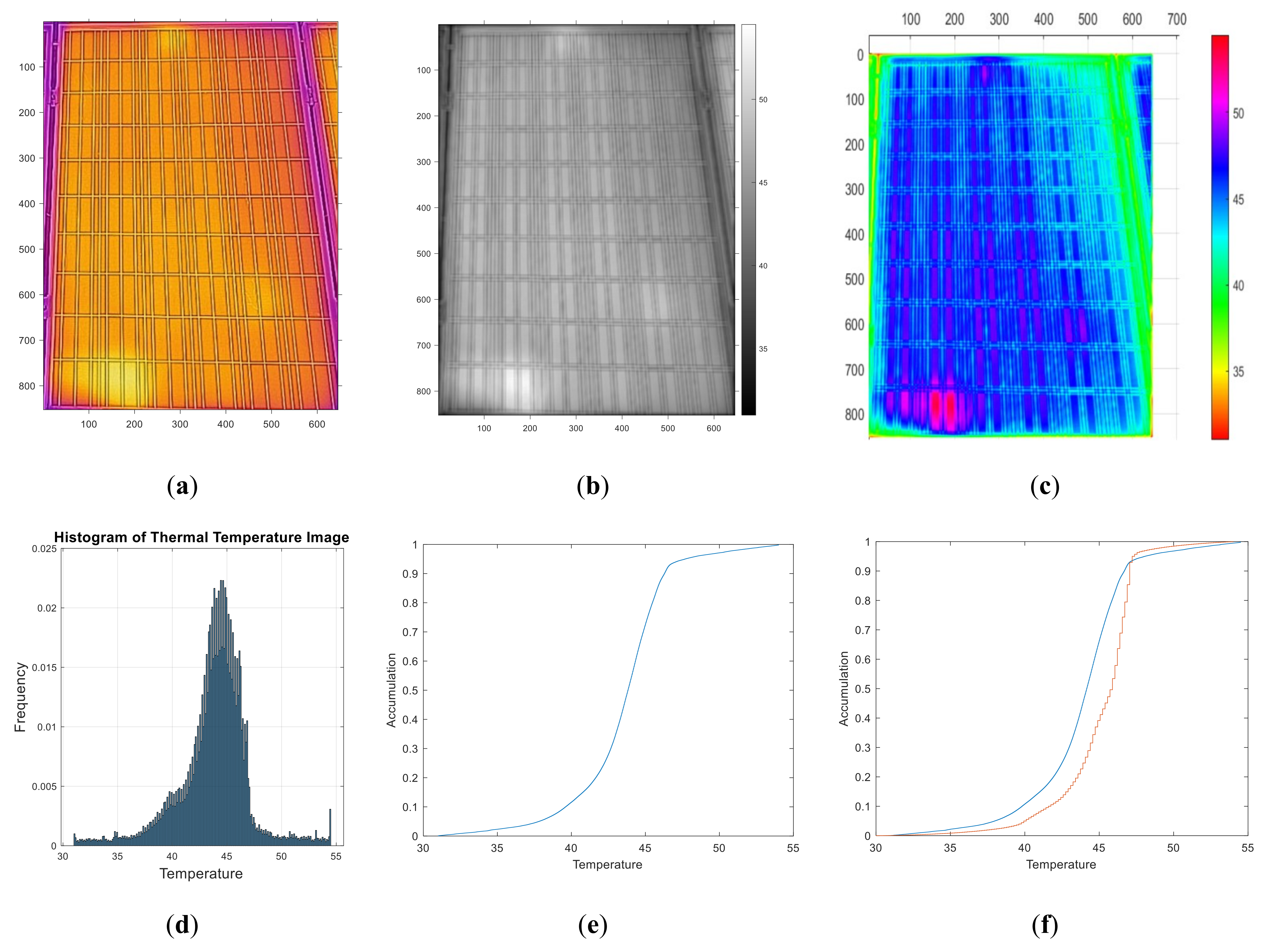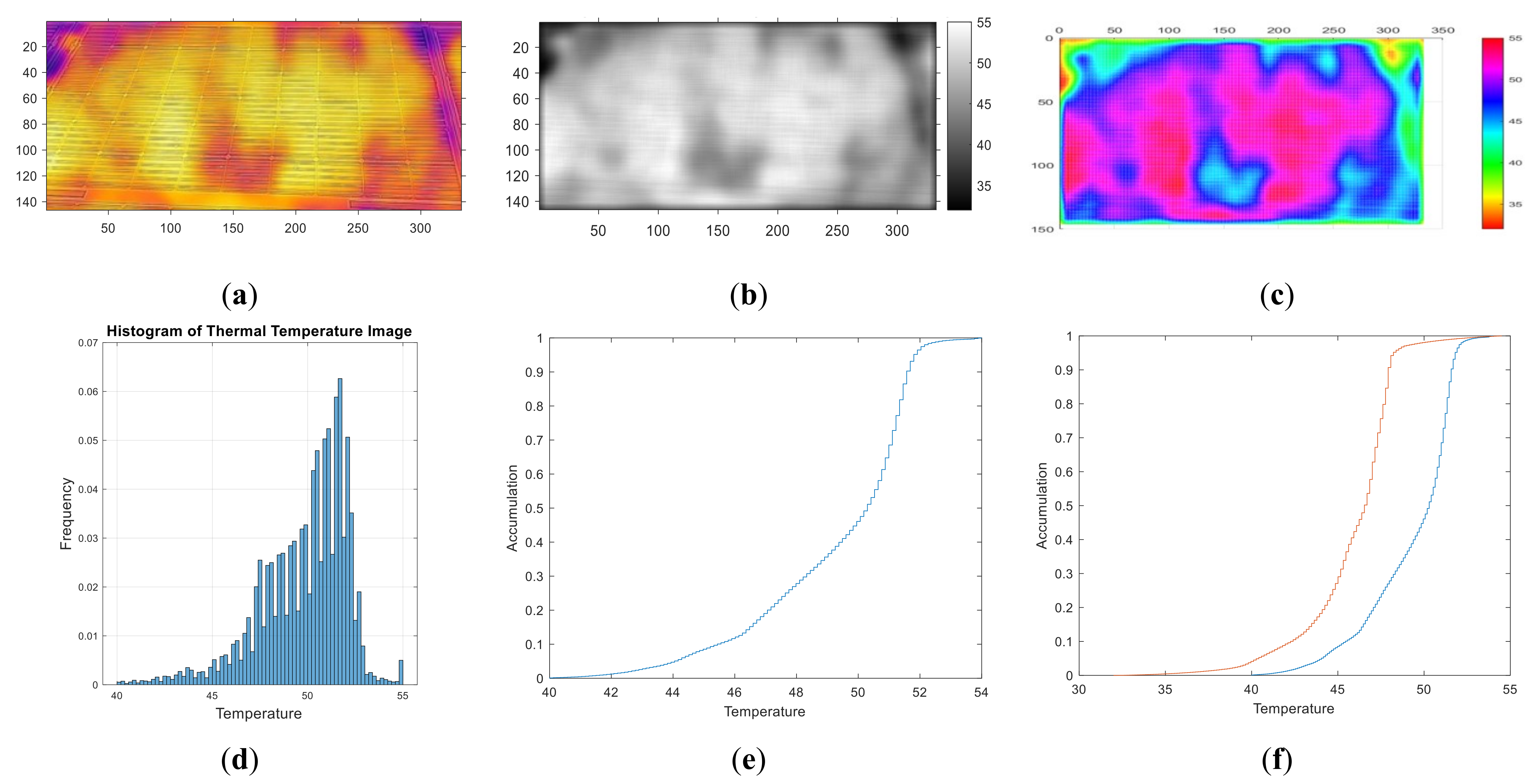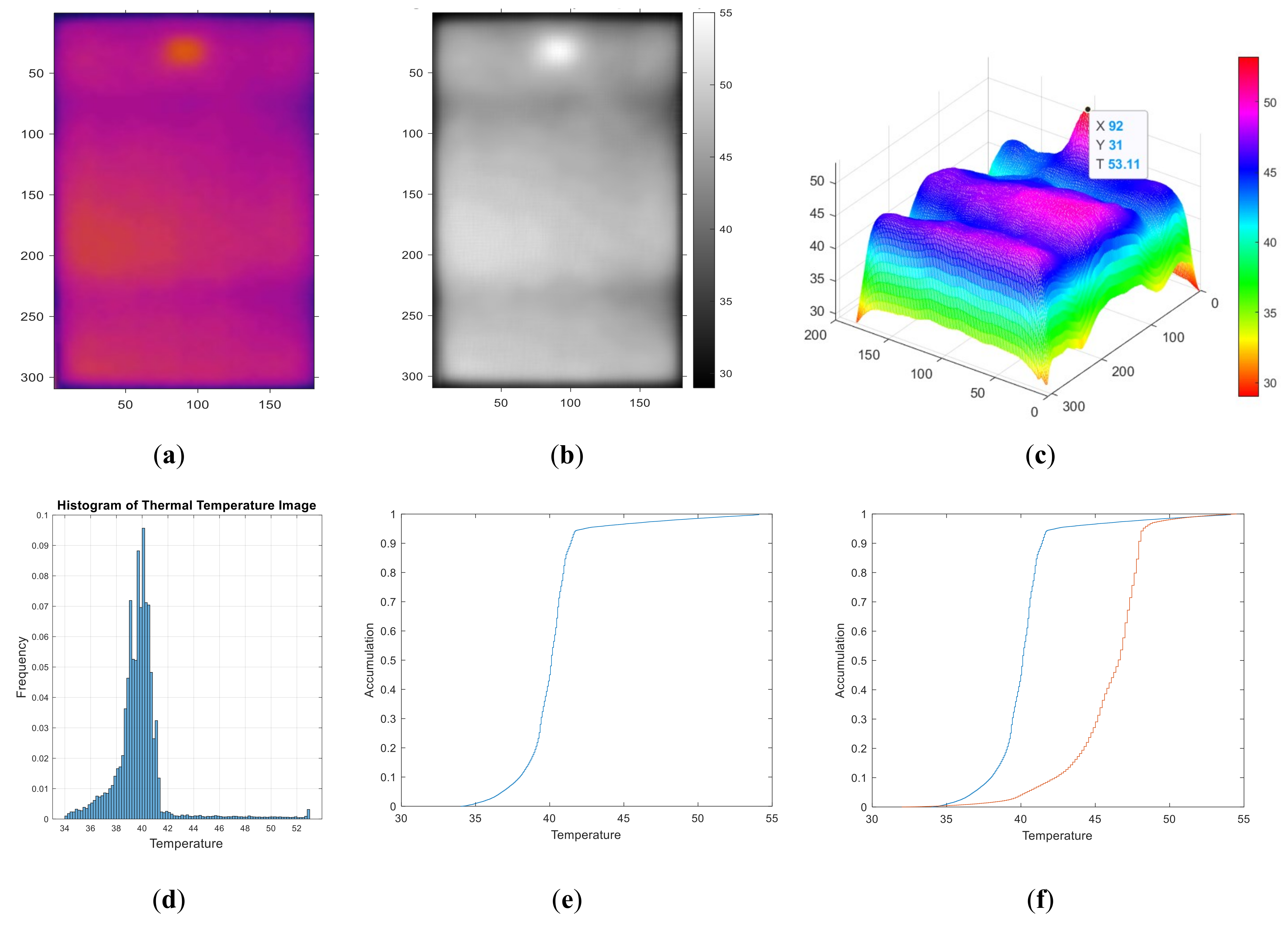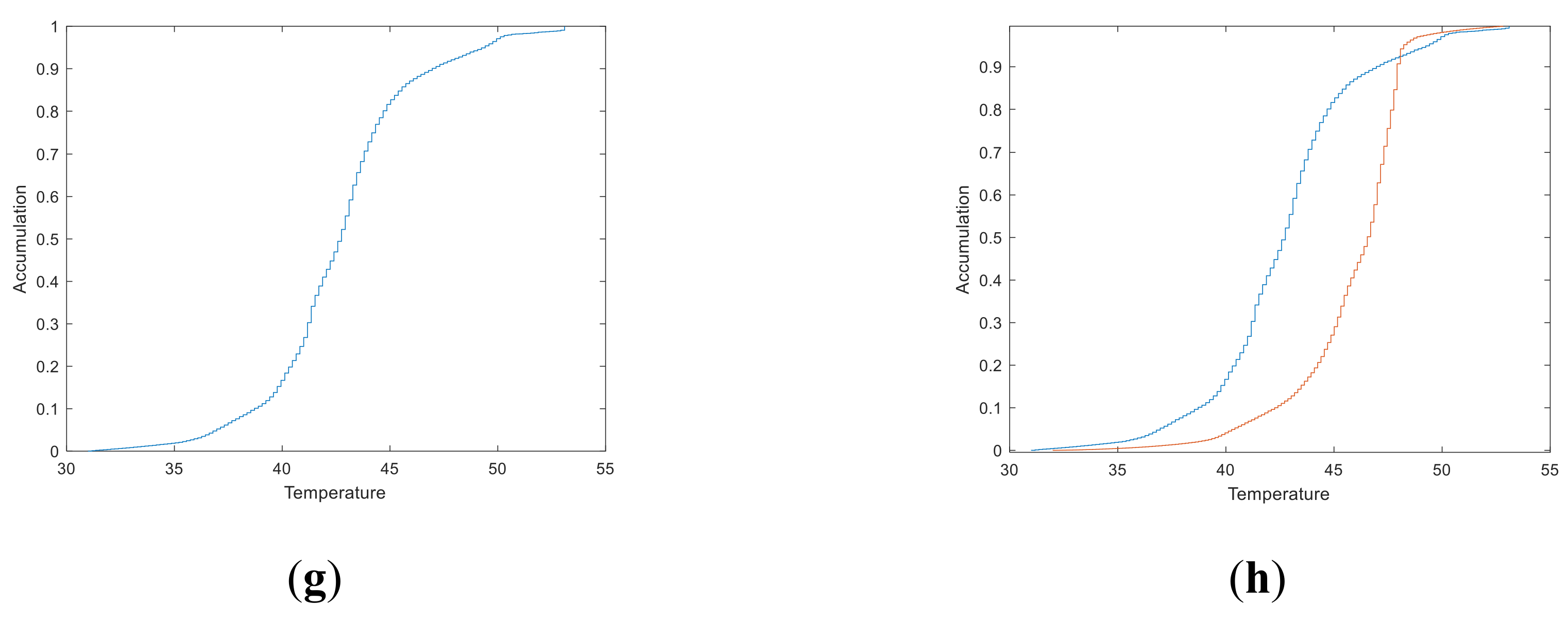In this study, thermal imaging analysis of solar photovoltaic modules was performed by infrared cameras (FLIR Duo R) mounted on the UAV, and IR images were immediately transmitted back to the ground station for analysis. After receiving the IR image, the ground station performs grayscale processing and Gaussian filtering. At the same time, 3-D images or color images are presented to increase the identification of defects. Finally, the IR image is analyzed through the image processing techniques introduced above. The location of the defect area is identified and the ratio of the fault area to the total area of the solar module is obtained.
Experiments were conducted in two stages. In the first stage, modules with known conditions were applied to locate the characteristics of IR images. Four modules were used in this stage, including one in good condition, and three with defects that are already known. In the second stage, unknown modules were applied for testing the validation of the process to improve the reliability and validity of this study. A total of six modules were applied in this stage.
3.1. The First Stage Experiments
Figure 5 shows the image of a healthy solar module.
Figure 5a is the original IR image of this healthy module in normal operation. It shows that basically the panel is of uniform temperature with color of yellowish orange. However, some areas with bright color can also be observed, indicating that higher temperature regions are distributed in the panel.
Figure 5b is an image converted to grayscale after Gaussian filtering. The temperature distribution in
Figure 5b was calibrated with a thermometer shown in
Figure 2. It shows that the whole panel was at around 48 °C while the normal operating temperature of a healthy solar module is 45 °C to 49 °C. However, there is a cell-sized hot spot in the top middle area of this panel and the accurate measurement of the area of this hot spot is 1.67% of the total area with a temperature 55 °C. The reason is that at the back of the panel, there is a junction box located just opposite to the hot spot region and the temperature in this region is comparatively higher than its neighborhood due to the thermal insulation of the junction box, and therefore it is not a malfunction or abnormality.
Solar cells are basic units of a solar panel. Several units of cells are connected in series and parallel, and encapsulated together to form a solar photovoltaic panel module. In this study, the experimental solar module is composed of 6 × 10 cells, making one solar module contains 60 cells. Failure of a single cell would account for 1/60 of the fault area (about 1.67%). The aforementioned hot spot occupied 1.67% of the total area, indicating only one cell is at relatively high temperature. As a result, the innovative method of this research can find not only hot spots, but also determine whether it is a hot spot caused by cell failure or contamination.
Figure 5c shows a 3-D image of the solar module in normal operation after Gaussian filtering. The temperature variations on the panel surface is converted to a three dimensional hills and valleys to signify the high temperature regions that could not be noticed in the two dimensional figure as shown in
Figure 5b. The peak on the upper middle is the hot region caused by the junction box on the opposite side of panel as mentioned before.
Figure 5d shows the histogram of the probability density of the calculated temperature value in each pixel. The temperature of a solar module in normal operation is not a normal distribution, but rather it looks like a Beta distribution with α = 8 and β = 2. The mean temperature is 48 °C with a deviation of −7 °C. The maximum temperature is 55 °C and the minimum temperature is 35 °C. The probability density function (PDF) of temperature distribution is a characteristic of a solar panel. In this paper, the PDF and the associated cumulative function are used as an important index to determine the health condition of a solar panel.
Figure 5e displays the cumulative distribution function (CDF) of the temperature distribution. It is found that 98.5% of the pixels are under 50 °C and only 1.5% of pixels exceed 50 °C. The above description shows that 98.5% of the panel is within the normal area, as displayed in
Figure 5d–e. It is noted that the hot spot area caused by the junction box on the back of the solar module is about 1.5%. Since the junction box is not a malfunction of the panel, we may therefore conclude that 1.5% of hot spot might not be a malfunction problem in the CDF curve. Further examination is needed to check if it is a normal operating panel.
The second experiment was conducted on three panels that have known defects. The location of these panels is on the GPS coordinates of 24°12′31″ N and 120°29′40″ E with an altitude of 5 m. The experiment was carried out on April 1, 2020, at 11 am. The outdoor temperature is 28 °C. The surface temperature of the normal operating solar module is 45~ 49 °C, and the surface temperature of the abnormal solar module is 50~55 °C with irradiance of 815 W/m2.
The first panel has a defective cell in the lower middle of the panel.
Figure 6a shows the original IR image with a clear and bright area shown in the lower middle that corresponds to the defected cell while a less bright area located in the upper middle is the junction box as mentioned before. Purple lines on the left and right margins are frames of the panel.
Figure 6b shows an image converted to grayscale after Gaussian filtering. Grid lines of the panel are blurred due to the filtering effect but the bright region still appears clearly.
Figure 6c displays a color image after Gaussian filtering to differentiate temperatures and the image tells that the hot spot is at about 55 °C and panel frames are at the temperature of 40 °C while the rest of the panel is at around 45~50 °C.
Figure 6d is the histogram of the temperature distribution. The PDF curve still looks like a beta distribution function but a bump can be found at 40 °C which was not shown in
Figure 5d of a normal operating panel because panel frames were not included in
Figure 5. The mean temperature of the whole panel is 46 °C with the deviation of −9 °C. The maximum temperature is 55 °C and the minimum temperature is 32 °C.
Figure 6e is the cumulative temperature distribution that the mean temperature, maximum temperature and minimum temperate are very close for a normal operating panel and a panel with a known defected cell. However, hot spots are clearly shown on the solar module in
Figure 6a–c. Through the cumulative chart, it is found that the percentage of hot spot area is over 3.1%, indicating there are two cells with high temperature. We already knew that one of the cells is caused by the junction box and there should be another cell in abnormally high temperature. To highlight the difference between a normal panel and a panel with known defected cell, we have compared the CDF curves of these two panels in
Figure 6f. Result shows that the percentage of the area over 50 °C is a good index to determine cell abnormality or failure. The above description shows that 96.9% of the panel is within the normal area, as displayed in
Figure 6d–e.
The second panel has two defected cells located in the lower middle of the panel.
Figure 7a shows the original IR image with a clear and bright area shown in the lower middle that corresponds to the defected cell.
Figure 7b shows an image converted to grayscale after Gaussian filtering.
Figure 7c shows a color image after Gaussian filtering that the hot spot is at about 55 °C. Panel frames are at the temperature of 38 °C and the rest of the panel is at around 45~50 °C.
Figure 7d displays the histogram after calculating the temperature value of each pixel. The PDF curve still looks like a beta distribution function and the bump with 38 °C is panel frames. The mean temperature is 43 °C with the deviation of −12 °C. The maximum temperature is 55 °C and the minimum temperature is 32 °C.
Figure 7e displays the cumulative temperature distribution that the percentage of hot spot area over 50 °C is 3.4%, indicating there are more than two cells with high temperature. Lastly,
Figure 5e and
Figure 7e are superimposed to form
Figure 7f for comparing normal and abnormal conditions.
Figure 7e shows that the area over 50 °C is about 3.4%, which is higher than the 1.5% threshold presumed for a normal solar module, indicating that more than one cell has abnormality or failure. The above description shows that 96.6% of the panel is within the normal area, as displayed in
Figure 7d–e. This is consistent with
Figure 7a–c, showing that the bright area of the hot spot is clearly visible.
The third panel has no defected cells but several drops of bird guano can be observed on the central middle of panel. This experiment tested irregular shaped hot spots that are often found in remote area.
Figure 8a shows the image of the panel obtained through a visual light camera. It is found that bird droppings could not be easily differentiated from its background by visual inspection because both the bird droppings and cells are of black color.
Figure 8b shows the original IR image with a bright color region at the central middle part of the panel which is the location of bird droppings. However, it is not brighter than its surrounding and it could be easily overlooked only by visual inspection of the IR image.
Figure 8c shows an image converted to grayscale after Gaussian filtering and it shows a clearer image of bird droppings than that in the original IR image because the grayscale magnified the color difference of image.
Figure 8d displays an artificial color image based on the grayscale of each pixel after Gaussian filtering. In
Figure 8c,d, the hot spot area is more obvious than that in
Figure 8b (as shown in the red circle). Unlike the rectangular shape of hot spot shown in
Figure 6c, which is caused by failed cells, the hot spot in
Figure 8e is of irregular shape.
Figure 8f displays the histogram of the PDF of the temperature values in each pixel and the bump with 45 °C is panel frames. The mean temperature is 48 °C with the deviation of −7 °C. The maximum temperature is 55 °C and the minimum temperature is 31 °C. The cumulative chart of CDF is shown in
Figure 8f. The percentage of the hot spot area over 50 °C can be obtained from the cumulative curve, which is 5.5% in this panel. The above description shows that 94.5% of the panel is within the normal area, as shown in
Figure 8e,f. Lastly,
Figure 5e and
Figure 8f are superimposed to form
Figure 8g for comparing normal operation and abnormal conditions. It seems that there are about 3–4 abnormal cells and the hot spot area in
Figure 8d is irregular and thus it is concluded that those 3–4 abnormal cells are caused by stains.
The innovative finding of this research depicts the following observations. When one cell (about 1.67%) on the solar module exceeds 50 °C, it means that a hot spot or abnormality occurs in one cell of the module, which may reduce the power generation of the module. The innovative method of this research can find not only hot spots, but also estimate the proportion of hot spots on a solar module. This may avoid the misinterpretation of hot spots caused by some small stains (such as bird droppings, branches, leaves, or dust) as cell failure. If the hot spot proportion is not multiples of 1.67% and the shape of hot spot is irregular, it can be determined that the solar module is contaminated and would only require simple cleaning. In fact, during the operation of the solar module, as long as the hot spots caused by cell failure or stains are distinguished, the correct judgment can be made for cleaning or maintenance. As a result, the service life of solar modules is increased and costs are reduced. Some of the results are presented in the following cases.
3.2. The Second Stage Experiments
In the second stage of experiments, modules with unknown conditions were used to test the findings of the first stage. A total of six modules were tested in this stage. Experiments were conducted at different locations in the verification field. In each case, one to three images were selected for verification. Verification locations and results are illustrated in the following cases:
In the first case, the power generation efficiency is low but no obvious damage was found by visual inspection. The location of these panels is on the GPS coordinates of 24°12′31″ N and 120°29′39″ E with an altitude of 5 m. The nominal output of this solar farm is 6486 kWp. The experiment was carried out on 1 April 2020, at 12 a.m. The outdoor temperature is 29 °C. The surface temperature of the normal operating solar module is 45~49 °C, and the surface temperature of the abnormal solar module is 50~56 °C with irradiance of 827 W/m2. Three panels were inspected in this paper following the procedure mentioned above.
The first panel has three hot spots with the brightest spot at the bottom left, followed by the bottom right and the top middle.
Figure 9a shows the original IR image with a clear and bright area in the bottom left that corresponds to the defected cell while a less bright area located in the upper middle is the junction box as mentioned before. In addition, a defected cell in the lower right of the panel can also be observed in the IR image with purple lines on the left and right margins as frames of the panel.
Figure 9b shows an image converted to grayscale after Gaussian filtering. Grid lines of the panel are blurred due to the filtering effect but the bright region still appears clearly.
Figure 9c shows a color image after Gaussian filtering to differentiate the temperature variations that the hot spot is at about 56 °C. Panel frames are at the temperature of 40 °C and the rest of the panel is at around 40~49 °C.
Figure 9d displays a histogram of the temperature distribution. The PDF curve still looks like a beta distribution function. However, a bump can be found at 38 °C which was not shown in
Figure 5d of a normal operating panel because panel frames were not included in
Figure 5. The mean temperature is 45 °C with the standard deviation of −11 °C. The maximum temperature is 56 °C and the minimum temperature is 30 °C.
Figure 9e displays the cumulative temperature distribution that the percentage of hot spot area over 50 °C is 3.3%, indicating there are more than two cells with high temperature. Finally,
Figure 5e and
Figure 9e are superimposed in
Figure 9f for comparing normal and abnormal conditions.
Figure 9e shows that the area over 50 °C is about 3.3%, which is higher than the 1.5% threshold presumed for a normal solar module, indicating that more than one cell has abnormality or failure. The above description shows that 96.7% of the panel is within the normal area, as shown in
Figure 9d,e. This is consistent with
Figure 9a–c, showing that bright area of hot spot is clearly visible.
The original IR image of the second panel at the same location is shown in
Figure 10a with a clear and bright area in the bottom right that corresponds to defected cells while a less bright area located in the upper middle is the junction box as mentioned before.
Figure 10b shows an image converted to grayscale after Gaussian filtering that the bright area still appears clearly after filtering.
Figure 10c shows a 3-D color image of the temperature distribution with a high rise hill occurs at the hot spot at about 55 °C. Panel frames are at the temperature of 40 °C while the rest of the panel is at around 43~48 °C.
Figure 10d shows a histogram of the temperature distribution. The PDF curve still looks like a beta distribution function and the bump with 40 °C corresponds to panel frames. The mean temperature is 44 °C with the deviation of −11 °C. The maximum temperature is 55 °C and the minimum temperature is 30 °C.
Figure 10e displays the cumulative temperature distribution that the percentage of hot spot area over 50 °C is 2.8%, indicating there are two cells exceeding the temperature threshold. Finally,
Figure 5e and
Figure 10e are superimposed in
Figure 10f for comparing normal and abnormal conditions.
Figure 10e shows that the area over 50 °C is about 2.8%, which is higher than the 1.5% threshold presumed for a normal solar module, indicating that almost one cell has abnormality or failure. The above description shows that 97.2% of the panel is within the normal area, as shown in
Figure 10d,e. This is consistent with
Figure 10a–c, showing that bright area of hot spot is clearly visible.
The original IR image of the third panel at the same location is shown in
Figure 11a with a clear and bright area in the bottom left that corresponds to defected cells while a less bright area located in the upper middle is the junction box as mentioned before.
Figure 11b shows an image converted to grayscale after Gaussian filtering. The grid in this image is still clearly visible after Gaussian filtering because the resolution of the original picture is higher for the third panel and the bright region still appears clearly after filtering.
Figure 11c shows a color image after Gaussian filtering to tell the temperature difference on the panel. It reveals that the hot spot is at about 54 °C. Panel frames are at the temperature of 40 °C while the rest of the panel is at around 45 ~ 49 °C.
Figure 11d shows a histogram of the temperature distribution. The PDF curve still looks like a beta distribution function and the bump with 40 °C is contributed by frames of the panel. The mean temperature is 44 °C with the deviation of −10 °C. The maximum temperature is 54 °C and the minimum temperature is 30 °C. In addition, there is a clear bump at 54 °C, which is a defect caused by hot spots. At the same time,
Figure 11e displays the cumulative temperature distribution that the percentage of hot spot area over 50 °C is 3.2%, indicating there are two cells exceeding the temperature threshold. Finally,
Figure 5e and
Figure 11e are superimposed in
Figure 11f for comparing normal and abnormal conditions. In
Figure 11e, the area over 50 °C is about 3.2% of the third panel, which is higher than the 1.5% threshold presumed for a normal solar module, indicating that one cell has abnormality or failure. The above description shows that 96.8% of the panel is within the normal area, as shown in
Figure 11d,e. This is consistent with
Figure 11a–c, showing that bright area of hot spot is clearly visible.
A brief conclusion can be drawn in the first case: The procedure of IR image analysis can search panels that have cells exceeding the temperature threshold effectively, as well as panels that have been confirmed to be abnormal.
In the second case, the power generation efficiency is low and no obvious damage is found by visual inspection. The location of these panels is on the GPS coordinates of 24°05′45″ N and 120°23′11″ E with an altitude of 5 m. The nominal output of this solar farm is 40 MWp. It is the largest solar farm installed in Taiwan so far. The experiment was carried out on 7 April 7 2020, at 1 p.m. The outdoor temperature is 24 °C. The surface temperature of the normal operating solar module is 45~49 °C, and the surface temperature of the abnormal solar module is 50~55 °C with irradiance of 746 W/m2. Only one panel was inspected with an IR image in this case.
Figure 12a shows the original IR image. The image of this panel looks different because the panel is installed horizontally instead of vertically at this location. There are lots of bright areas on this panel, but the number of hot spots cannot be immediately recognized in the image.
Figure 12b shows an image converted to grayscale after Gaussian filtering. Grid lines of the panel are blurred due to the filtering effect but bright areas are more visible than infrared images.
Figure 12c shows a color image after Gaussian filtering to demonstrate the temperature difference on the panel that the hot area is at about 55 °C. Panel frames are at the temperature of 43 °C while the rest of the panel is at around 45~49 °C.
Figure 12d shows a histogram of the temperature distribution. The PDF curve still looks like a beta distribution function. The mean temperature is 50 °C. The maximum temperature is 55 °C and the minimum temperature is 40 °C. The average temperature of this panel is relatively high and there are many defective cells causing hot spots.
Figure 12e displays the cumulative temperature distribution that the percentage of hot spot area over 50 °C is 53.8%, indicating more than half of the cells in this panel are defective. Finally,
Figure 5e and
Figure 12e are superimposed to form
Figure 12f for comparing normal and abnormal conditions.
Figure 12e shows that the area over 50 °C is about 53.8%, which is higher than the 1.5% threshold presumed for a normal solar module, indicating that 31 cells have abnormality or failure. The above description shows that only 46.2% of the panel is normal, as shown in
Figure 12d,e. This is consistent with
Figure 12a–c.
In the third case, the power generation efficiency is normal and no obvious damage is found by visual inspection. The location of these panels is on the GPS coordinates of 24°03′59″ N and 120°42′56″ E with an altitude of 169 m. The nominal output of this solar farm is 6 kWp. The experiment was carried out on 20 August 2020, at 10 a.m. The outdoor temperature is 28 °C. The surface temperature of the normal operating solar module is 45~49 °C, and the surface temperature of the abnormal solar module is 50~53 °C with irradiance of 776 W/m2. Two panels were inspected with IR images in this case.
Figure 13a shows the original IR image of the first panel with a clear and bright area in the top middle that corresponds to a defected cell while the upper middle is the junction box as mentioned before. The dark purple lines around the cells are frames of the panel.
Figure 13b shows an image converted to grayscale after Gaussian filtering but the bright region still appears clearly.
Figure 13c shows a 3-D color image after Gaussian filtering to tell the temperature difference that the hot spot in the top middle is at about 53 °C. Panel frames are at the temperature of 43 °C while the rest of the panel is at around 45~49 °C.
Figure 13d shows a histogram of the temperature distribution. The PDF curve still looks like a beta distribution function. The mean temperature is 42 °C with the deviation of −11 °C. The maximum temperature is 53 °C and the minimum temperature is 30 °C.
Figure 13e displays the cumulative temperature distribution that the percentage of hot spot area over 50 °C is 1.6%, indicating there is only one cell exceeding the temperature threshold. Finally,
Figure 5e and
Figure 13e are superimposed in
Figure 13f for comparing normal and abnormal conditions. It is found that the area over 50 °C is about 1.6%, which is close to the 1.5% threshold presumed for a normal solar module, indicating that there is no abnormality or failure. The above description shows that 98.5% of the panel is within the normal area, as shown in
Figure 13d,e. This is consistent with
Figure 13a–c, which shows that bright area of hot spot is clearly visible.
The second panel at the same location has a wide bright area in the upper part as shown in
Figure 14a,b and it is a visible light image, not an IR image. This bright area is caused by the direct reflection of sunlight.
Figure 14d shows the IR image of the same panel taken at the same time as the visual light image. The wide bright area of reflection disappears but a clear and bright zone with a smaller area still exists in the right middle that corresponds to defected cells.
Figure 14e shows an image converted to grayscale after Gaussian filtering and the bright zone still appears clearly.
Figure 14f shows a histogram of the temperature distribution. The PDF curve still looks like a beta distribution function and the huge bump with 41 °C is caused by panel frames. The mean temperature is 43 °C with the deviation of −10 °C. The maximum temperature is 53 °C and the minimum temperature is 30 °C.
Figure 14g displays the cumulative temperature distribution that the percentage of hot spot area over 50 °C is 3%, indicating there is one cell with high temperature. Finally,
Figure 5e and
Figure 14g are superimposed in
Figure 14h for comparing normal and abnormal conditions.
Figure 14g shows that the area over 50 °C is about 3%, which is 1.5% higher than threshold presumed for a normal solar module, indicating that there is one cell abnormality or failure. The above description shows that 97% of the panel is within the normal area, as shown in
Figure 14f,g.
However, this is a normal operating panel and there are no defected cells occurred. The results of IR image analysis seem to be contracted with the real situation, indicating that there is a blind spot for this analysis procedure that could happen when there is direct reflection of sunlight on the panel. To avoid this blind spot, it is suggested that the visible light image should be inspected to check whether there is any reflection on the panel before the IR image analysis is conducted. Therefore, the visible light images at different time periods can be used to determine whether it is reflective. For example,
Figure 14c is the photo of the same modules, but the shooting timing is a few seconds later. We can see that the flare in
Figure 14a disappeared in
Figure 14c. If the flare is caused by any malfunctions, it would not disappear just a few seconds later. So we may determine that the flare is caused by direct reflection which is strongly affected by the angle of shooting. To ensure the completeness and validity of this analysis procedure, the image is removed to prevent misjudgment if the image of the panel has reflection when the photo is taken.

